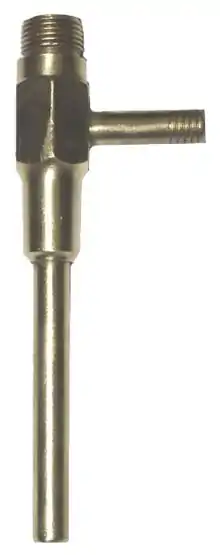Vacuum ejector
A vacuum ejector, or simply ejector is a type of vacuum pump, which produces vacuum by means of the Venturi effect.
 A brass aspirator. The water inlet and outlet are at the top and bottom, respectively; the air inlet is on the side. | |
| Other names | Eductor-jet pump, injector/ejector, filter pump, Venturi pump |
|---|---|
| Uses | Vacuum generation, suction |
| Related items | Injector, vacuum pump |
In an ejector, a working fluid (liquid or gaseous) flows through a jet nozzle into a tube that first narrows and then expands in cross-sectional area. The fluid leaving the jet is flowing at a high velocity which due to Bernoulli's principle results in it having low pressure, thus generating a vacuum. The outer tube then narrows into a mixing section where the high velocity working fluid mixes with the fluid that is drawn in by the vacuum, imparting enough velocity for it to be ejected, the tube then typically expands in order to decrease the velocity of the ejected stream, allowing the pressure to smoothly increase to the external pressure.
The strength of the vacuum produced depends on the velocity and shape of the fluid jet and the shape of the constriction and mixing sections, but if a liquid is used as the working fluid the strength of the vacuum produced is limited by the vapor pressure of the liquid (for water, 3.2 kPa or 0.46 psi or 32 mbar at 25 °C or 77 °F). If a gas is used, however, this restriction does not exist.
If not considering the source of the working fluid, vacuum ejectors can be significantly more compact than a self-powered vacuum pump of the same capacity.
Common types
Water aspirator
The cheap and simple water aspirator is commonly used in chemistry and biology laboratories and consists of a tee fitting attached to a tap and has a hose barb at one side. The flow of water passes through the straight portion of the tee, which has a restriction at the intersection, where the hose barb is attached. The vacuum hose should be connected to this barb. In the past, water aspirators were common for low-strength vacuums in chemistry benchwork. However, they are water-intensive, and depending on what the vacuum is being used for (e.g. solvent removal), they can violate environmental protection laws such as the RCRA by mixing potentially hazardous chemicals into the water stream, then flushing them down a drain that often leads directly to the municipal sewer. Their use has decreased somewhat as small electric vacuum pumps are far more effective, environmentally safe, and have become more affordable, but the unmatched simplicity and reliability of this device have caused it to remain popular for small labs or as a backup.
Steam ejector
The industrial steam ejector (also called the "steam jet ejector", "steam aspirator", or "evactor") uses steam as a working fluid and multistage systems can produce very high vacuums. Due to the lack of delicate moving parts and the flow of steam providing somewhat of cleaning action, steam ejectors can handle gas flows containing liquids, dust, or even solid particles that would damage or clog many other vacuum pumps. Ejectors made entirely from specialised materials such as PTFE or graphite have allowed usage of extremely corrosive gasses, since steam ejectors have no moving parts they can be constructed in their entirety from almost any material that has sufficient durability.
In order to avoid using too much steam or impractical operating pressures, a single steam-ejector stage is generally not used to generate vacuum below approximately 10 kPa (75 mmHg).[1] To generate higher vacuum, multiple stages are used; in a two-stage steam ejector, for example, the second stage provides vacuum for the waste steam output by the first stage. Condensers are typically used between stages to significantly reduce the load on the later stages. Steam ejectors with two, three, four, five and six stages may be used to produce vacuums down to 2.5 kPa, 300 Pa, 40 Pa, 4 Pa, and 0.4 Pa, respectively.[1]
Steam ejectors are also suitable for pumping many liquids since if the steam can be easily condensed into the liquid then there is no need to separate the working fluid or manage a mist of liquid droplets. This is the manner in which a steam injector operates.
Air ejector
Commonly called an air ejector, Venturi pump, or vacuum ejector. This ejector is similar in operation to the steam ejector but uses high-pressure air as the working fluid. Multistage air ejectors can be used, but since air cannot easily be condensed at room temperature, an air ejector is usually limited to two stages as each subsequent stage would have to be significantly larger than the last. These are commonly used in pneumatic handling equipment when a small vacuum is required to pick up objects since compressed air is often already present to power other parts of the equipment. Air ejectors used to suction liquids directly will produce a fine mist of droplets, this is how airbrushes and many other spraying systems operate, but when a spray is not required it is typically an undesirable effect that limits the applications to gas suction.

See also
References
- High Vacuum Pumping Equipment, B. D. Power, New York: Reinhold Publishing Corporation, 1966, chapter 4.
